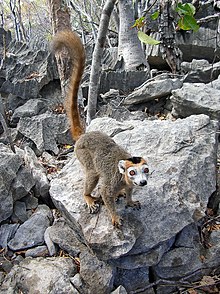安卡拉纳保护区
| 安卡拉纳保护区 | |
|---|---|
IUCN分类IV(生境和物种管理保护区) | |
 保护区入口的地图 | |
| 位置 | 马达加斯加迪亚纳大区 |
| 最近城市 | 安齐拉纳纳 |
| 坐标 | 13°4′22″S 48°54′53″E / 13.07278°S 48.91472°E |
| 面积 | 182平方千米(70平方哩) |
| 建立 | 1956年2月10日 |
| 管理机构 | 马达加斯加国家公园 |
安卡拉纳保护区(法语:Réserve spéciale d'Ankarana)是马达加斯加迪亚纳大区的一个保护区,成立于1956年。保护区境内有由中侏罗纪时期的石灰岩所组成、由部分植被覆盖的高原。 [1]该保护区年平均降雨量约2,000毫米[1],保护区内部分岩石被侵蚀而形成洞穴,并形成伏流,这是一种喀斯特地形,崎岖的地形与茂密的植被阻碍人类进入该地区。
保护区南部的入口位于马哈马西娜(Mahamasina),有6号国道经过。此处位于安齐拉纳纳西南方约108公里,安比卢贝东北方约29公里。该保护区于2008年列为马达加斯加世界遗产预备名单,编号5314[2]。

地理
[编辑]高原的东面缓慢倾斜,但西面突然止于一个从北向南延伸25公里的陡峭悬崖,称“安卡拉纳之墙”(Wall of Ankarana),此墙高达280米[3]。在南面,石灰岩块断裂成独立的尖顶,被称为塔式岩溶(tower karst)。在高原的中心,地震活动和亿万年的降雨将石灰岩溶解在深谷中,有时会重新沉积成流石带。在钙化的上层被完全侵蚀的地方,较硬的基岩被蚀成“黥基”(马达加斯加语:tsingy,意为人类无法涉足之地)的通道和山脊。该地区到处都是玄武岩巨石,玄武岩也渗入山块深处的峡谷中[3]。
探索
[编辑]1960年代起,旅居国外的法国人让·杜弗洛斯(Jean Duflos,在当地结婚后改名为让·拉多菲劳,Jean Radofilao)与洞穴学家一起对山块的洞穴系统和地下河进行探索[4][5][6]。他们绘制了山块内约100公里的洞穴通道[7]。安德拉菲贝洞穴是最容易进入的洞穴之一,仅该洞穴就包括至少8.035公里的水平通道。该山丘有马达加斯加最长的洞穴系统,也是非洲最大的地下洞穴网络[8]。
动物
[编辑]
安卡拉纳保护区探险队1980年代起对保护区的动植物进行编目[9],此记载于珍·威尔逊-霍华斯博士的游记《失落的世界之狐猴》[10]以及多个科学出版物中[11][12][13][14]。保护区发现已灭绝大型狐猴的亚化石遗骸[15][16][17][18],以及仍存在但尚未有记载的盲鱼[19][20]、虾[21],以及其他无脊椎动物物种[22][23]。几位探险队成员提供照片给一本马达加斯加图说指南,该指南以安卡拉纳的鳄鱼洞为特色点[24]。
在1986年考察期间,菲尔·查普曼(Phil Chapman)和让-埃利·兰德里亚马西(Jean-Elie Randriamasy)整理了一份保护区鸟类名单,记录32个科的65种鸟类,占马达加斯加所有鸟类近三分之一,他们还注意到一种有趣的行为。他们报告指出,许多以昆虫为食的小鸣禽使用一种不同寻常的策略:包括马达加斯加寿带鸟、北杂鹛、短嘴旋木鹎、马岛旋木鹎、马岛黑鹎、斯韦花蜜鸟、白额厚嘴鵙等物种在一起觅食,不同的鸟类似乎都专注于牠们特定的区域觅食昆虫猎物,一些集中于树干与大分枝、一些集中于小树枝、一些集中于树叶下方。通过这样的方式共同行动,牠们可能会提高觅食效率,因为各种鸟类都可以捕捉到目标猎物,也更安全地免受掠食者的攻击,因为一大群鸟类分头警戒,更有可能发现接近中的危险处。[13]
安卡拉纳保护区是冠狐猴、桑氏美狐猴,和其他哺乳动物种的重要栖息地。其他发现的物种包括北鼬狐猴、赤褐倭狐猴、肥尾鼠狐猴、叉斑鼠狐猴、东部毛狐猴、冕狐猴、佩氏冕狐猴、指猴、灰驯狐猴。[13]
此外,保护区内还发现一些狐猴的亚化石,包括大竹狐猴、大狐猴、拟大狐猴、中原狐猴、古原狐猴、古狐猴等。[17][18]
参见
[编辑]参考文献
[编辑]- ^ 1.0 1.1 Rossi, G. Morphologie et Evolution d'un karst en milieu tropical. L'Ankarana (Extreme Nord de Madagascar). Mémoires et Documents Centre National de la Recherche Scientifique. 1974, 15: 279–298.
- ^ Les forêts sèches de l’Andrefana. World Heritage Convention. UNESCO World Heritage Centre. [2023-05-11]. (原始内容存档于2008-09-04).
- ^ 3.0 3.1 Reader's Digest. Natural Wonders of the World. 1980: 48. ISBN 0-89577-087-3.
- ^ Duflos, J. Bilan des explorations biospeleologique pour l'annee 1965. Revue de Géographie (Université de Madagascar). 1966, 9: 225–252.
- ^ Duflos, J. Bilan des explorations speleologique pour l'annee 1966. Revue de Géographie (Université de Madagascar). 1968, 12: 121–129.
- ^ Peyre, J-C.; Arthaud, G.; Radofilao, J.; et al. Expédition Spéléologique, Madagascar 1982. Club Alpin Francais / Federation Francaise de Spéléologie: 55pp. 1982.
- ^ Wilson, Jane (编). The Crocodile Caves of Ankarana : Expedition to Northern Madagascar, 1986. Cave Science. 1987, 14 (3): 107–119.
- ^ Réserve Spéciale Ankarana - Aventure mystique au sein du plus grand réseau souterain d'Afrique. Madagascar National Parks. [2022-05-22]. (原始内容存档于2022-05-22) (法语).
- ^ Wilson, Jane M. The Crocodile Caves of Ankarana, Madagascar. Oryx. 1987, 21 (1): 43–47. doi:10.1017/S0030605300020470
 .
.
- ^ Wilson, Jane. Lemurs of the Lost World: exploring the forests and Crocodile Caves of Madagascar. Impact, London. 2014: 216. ISBN 9781874687481.
- ^ Wilson, Jane M; et al. Ankarana - a rediscovered nature reserve in northern Madagascar. Oryx. 1988, 22 (3): 163–171. doi:10.1017/S0030605300027794
 .
.
- ^ Wilson, J.M.; et al. Ecology and Conservation of the Crowned Lemur at Ankarana, N. Madagascar with notes on Sanford's Lemur, Other Sympatrics and Subfossil Lemurs. Folia Primatologica. 1989, 52 (1–2): 1–26. PMID 2807091. doi:10.1159/000156379.
- ^ 13.0 13.1 13.2 Fowler, S.V.; et al. A survey and management proposals for a tropical deciduous forest reserve at Ankarana in northern Madagascar. Biological Conservation. 1989, 47 (4): 297–313. doi:10.1016/0006-3207(89)90072-4.
- ^ Stewart, Paul D. Ankarana damaged. Oryx. 1988, 22 (4): 240–241. doi:10.1017/S0030605300022390
 .
.
- ^ Simons, E.L.; et al. Discovery of new giant subfossil lemurs in the Ankarana Mountains of Northern Madagascar. Journal of Human Evolution. 1990, 19 (3): 311–319. doi:10.1016/0047-2484(90)90072-J.
- ^ Simons, E.L.; et al. A new giant subfossil lemur, Babakotia, and the evolution of sloth lemurs. Folia Primatologica. 1992, 58 (4): 197–203. doi:10.1159/000156629.
- ^ 17.0 17.1 Godfrey, L.R.; Wilson, Jane M.; Simons, E.L.; Stewart, Paul D.; Vuillaume-Randriamanantena, M. Ankarana: window to Madagascar's past. Lemur News. 1996, 2: 16–17.
- ^ 18.0 18.1 Wilson, Jane M.; Godfrey, L.R.; Simons, E.L.; Stewart, Paul D.; Vuillaume-Randriamanantena, M. Past and Present Lemur Fauna at Ankarana, N. Madagascar. Primate Conservation. 1995, 16: 47–52.
- ^ Banister, K.E. Glossogobius ankaranensis, a new species of blind cave goby from Madagascar. Journal of Ichthyology & Aquatic Biology. 1994, 1 (3): 25–28.
- ^ Wilson, Jane M. Conservation and ecology of a new blind fish, Glossogobius ankaranensis from the Ankarana Caves, Madagascar. Oryx. 1996, 30 (3): 218–221. doi:10.1017/S0030605300021669
 .
.
- ^ Gurney, A.R. Freshwater shrimp genera Caridina and Parisia (Decopoda: Caridea: Atydae) of Madagascar with descriptions of new species. Journal of Natural History. 1984, 18: 567–590. doi:10.1080/00222938400770481.
- ^ Jane M. Wilson. A review of world Troglopedetini (Insecta, Collembola, Paronellidae), including an identification table and descriptions of new species. Cave Science. 1982, 9 (3): 210–226.
- ^ José G. Palacios-Vargas & Jane Wilson. Troglobius coprophagus, a new genus and species of cave collembolan from Madagascar with notes on its ecology (PDF). International Journal of Speleology. 1990, 19 (1–4): 67–73 [2011-07-24]. doi:10.5038/1827-806X.19.1.6. (原始内容 (PDF)存档于2011-07-23).
- ^ Bradt, Hilary (编). Madagascar. Aston Publications, Bourne End, UK. 1988: 96. ISBN 0-946627-28-2.
外部链接
[编辑]- 安卡拉纳保护区官方网站 (页面存档备份,存于互联网档案馆) (法文)


